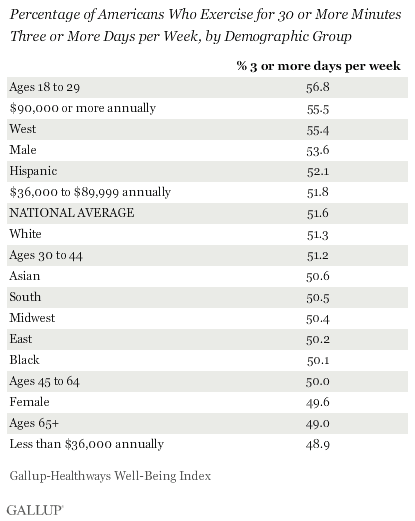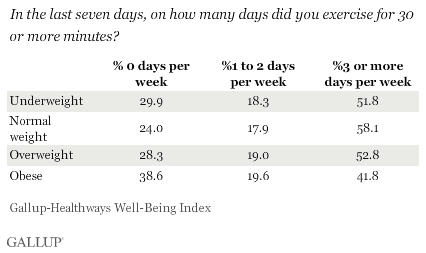WASHINGTON, D.C. -- About half of Americans (51.6%) reported that they exercised three or more days per week in 2011, essentially unchanged from 2010. In addition, slightly fewer Americans said they exercised zero days per week last year, dropping to 29.7% from 30.2% in 2010.

Americans' exercise habits had worsened slightly in 2009 amid the recession, but have since recovered.
Gallup and Healthways ask at least 1,000 Americans each day -- more than 350,000 surveys per year -- about their exercise frequency. Specifically, respondents are asked to report on how many days in the last seven they exercised for at least 30 minutes.
While Americans generally exercise more in the spring and summer and less in the fall and winter, the percentages who are exercising frequently this winter are higher than in the past. The percentage of Americans who exercised frequently in December, January, and February compared with the same months in past years is up.
The mild winter weather may be a contributing factor to this increased level of frequent exercise, as January 2012 was the fourth warmest January on record in the United States.
In December 2011, 47.4% of Americans exercised for at least 30 minutes three or more days per week, more than in the same month in 2010, 2009, or 2008. This trend continued into 2012, with 49.1% of Americans exercising frequently in January and 51% in February -- more than in the same months in past years.

Young Adults, High-Income Americans, and Those in the West Still Exercise Most
Young adults aged 18 to 29 (56.8%), those making $90,000 or more per year (55.5%), and people living in the West (55.4%) remained the most likely to exercise frequently in 2011, as they have in past years.
Americans making less than $36,000 annually (48.9%) and those aged 65 years old and older (49.0%) continue to be among the least likely to report frequent exercise, though their percentages are not dramatically lower than the highest groups.
Men are still more likely than women are to report a high level of physical activity.

Obese Americans Less Likely to Exercise
Obese Americans are significantly more likely than those who are a normal weight to report that they do not exercise for at least 30 minutes on any day in a given week and less likely to exercise frequently. Normal weight Americans are more likely than those in any other weight group to report frequent exercise, with an average of 58.1% saying they exercised for at least 30 minutes three or more days per week in 2011.

Gallup determines weight categories based on respondents' self-reports of their height and weight, which are then used to calculate standard Body Mass Index (BMI) scores. Individual BMI values of 30 or higher are classified as "obese."
Bottom Line
While a slim majority of Americans are exercising frequently, nearly half are not, including 29.7% who report not exercising for 30 minutes on any day in the past week. Additionally, the percentage who exercise frequently has not increased significantly since Gallup and Healthways started tracking Americans' exercise habits in 2008.
The benefits of exercise are well-known and include reduced risk of cardiovascular disease and type 2 diabetes, better mood, weight control, and a longer life span.
Certain groups continue to struggle more than others to get enough exercise -- obese Americans in particular, as well as those who report making less than $36,000 annually and seniors. These groups would particularly benefit from more regular exercise.
Changing Americans' exercise habits is not easy, but many leaders are trying. First Lady Michelle Obama's nationwide "Let's Move!" initiative, which aims to get all Americans exercising more and eating healthier, celebrated its second anniversary in February. Additionally, more physicians are attempting to get Americans moving. A new report from the Centers for Disease Control and Prevention finds that more patients are receiving prescriptions for exercise from their doctors as a means of maintaining or improving their health than in the past. However, the Gallup-Healthways Well-Being Index data reveal that despite the increasing role the White House and doctors are playing in encouraging Americans to exercise, moving the needle on a national scale remains a challenge.
Still, while the annual trends in exercise have not changed much over the past four years, Gallup and Healthways did find year-over-year increases in frequent exercise in December, January, and February, but it is unclear at this point whether the trend will persist.
About the Gallup-Healthways Well-Being Index
The Gallup-Healthways Well-Being Index tracks well-being in the U.S., U.K., and Germany and provides best-in-class solutions for a healthier world. To learn more, please visit well-beingindex.com.
Survey Methods
Results are based on telephone interviews conducted as part of the Gallup-Healthways Well-Being Index survey Jan. 1-Dec. 31, 2011, with a random sample of 335,050 adults, aged 18 and older, living in all 50 U.S. states and the District of Columbia, selected using random-digit-dial sampling.
For results based on the total sample of national adults, one can say with 95% confidence that the maximum margin of sampling error is ±0.2 percentage points.
For results based on subgroups, one can say with 95% confidence that the maximum margin of sampling error is ±1 percentage point.
Interviews are conducted with respondents on landline telephones and cellular phones, with interviews conducted in Spanish for respondents who are primarily Spanish-speaking. Each sample includes a minimum quota of 400 cell phone respondents and 600 landline respondents per 1,000 national adults, with additional minimum quotas among landline respondents by region. Landline telephone numbers are chosen at random among listed telephone numbers. Cell phone numbers are selected using random-digit-dial methods. Landline respondents are chosen at random within each household on the basis of which member had the most recent birthday.
Samples are weighted by gender, age, race, Hispanic ethnicity, education, region, adults in the household, and phone status (cell phone only/landline only/both, cell phone mostly, and having an unlisted landline number). Demographic weighting targets are based on the March 2010 Current Population Survey figures for the aged 18 and older non-institutionalized population living in U.S. telephone households. All reported margins of sampling error include the computed design effects for weighting and sample design.
In addition to sampling error, question wording and practical difficulties in conducting surveys can introduce error or bias into the findings of public opinion polls.
For more details on Gallup's polling methodology, visit www.gallup.com.
